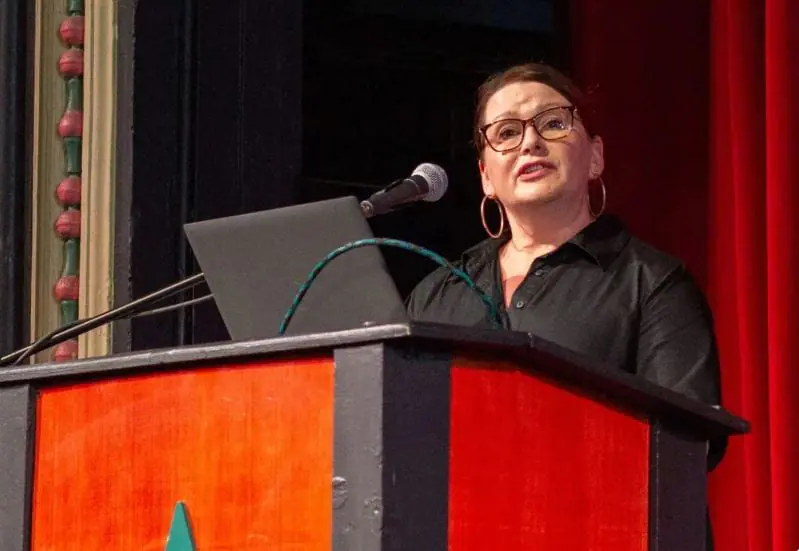‘This is predictable’: Homelessness up slightly in Indianapolis
INDIANAPOLIS (MIRROR INDY) — Homelessness isn’t an unsolvable problem in Indianapolis.
At least not the way Chelsea Haring-Cozzi sees it.
Haring-Cozzi, executive director of the Coalition for Homelessness Intervention and Prevention (CHIP), spoke from a stage June 26 at the Athenaeum Basile Theater and told advocates and policymakers that if you know what to look for, none of this is surprising.
“If we understand the key drivers, this is predictable,” she said at the 2024 State of Homelessness in Indianapolis.
At least 40% of Marion County households can’t cover the cost of living. Almost two-thirds of renting households in the county earned less than $50,000 in 2022. About one-third of households spent at least 30% of their income on housing in 2022, which means they’re considered cost-burdened, according to the National Low Income Housing Coalition.
And perhaps most telling: There were an average of more than 1,000 combined evictions and foreclosures per month in 2022.
All of it was meant to provide context to the number that signals how well the city is — or isn’t — doing to end homelessness.
This year, that number was 1,701.
That’s how many people were experiencing homelessness the night of Jan. 24.
The point-in-time count is a single-night census of homelessness, so it doesn’t necessarily reflect the full extent of homelessness in Indianapolis. In reality, the number can fluctuate every day.
But the snapshot is a useful look over time — not only in Indianapolis but throughout the country. Participating cities present their findings to Congress in the Annual Homeless Assessment Report, which helps determine national priorities and funding.
Plus, the U.S. Department of Housing and Urban Development (HUD) requires cities to conduct the annual count in order to receive funding.
To get the data, volunteers surveyed and counted people staying in emergency shelters, transitional housing programs and unsheltered locations such as a car or abandoned building.
This year’s snapshot revealed a small uptick in homelessness, along with persistent disparities.
What the numbers show
The overall number of people experiencing homelessness during this year’s count — 1,701 — is a 5% increase from 2023.
It also is still slightly higher than pre-pandemic numbers. In 2020, just before the pandemic, volunteers counted 1,588 people.
But homelessness doesn’t impact everyone equally.
The annual count revealed a continuing disparity for Black residents, who made up 53% of everyone experiencing homelessness. That’s despite representing only about a third of Marion County residents.
And 67% of families with children under 18 were Black.
“That is absolutely unacceptable,” said Abe Roll, CHIP’s data narrator.
The Indianapolis Continuum of Care, a coalition of housing advocates that helps guide the city’s response, has a goal to reduce Black homelessness by 35% by 2025.
Black young adults also are overrepresented.
Volunteers counted 79 unaccompanied young adults — ages 18-24 — this year, and 59% of them were Black. In 2023, that number was 45%.
The number of people who are unsheltered decreased slightly, down to 339. That’s about 5% lower than last year. Still, that’s 72% more than the 202 counted in 2022, and weather may have skewed the count this year.
The report notes it was cold, foggy and raining on the night of the count. Roll said volunteers heard from some people who were sheltered that night but said they typically would be outside.
And for Black residents, the numbers again are lopsided. There were 116 Black people unsheltered this year, which is a 25% increase from 2023.
The data is important, Haring-Cozzi said, because it can help advocates understand what causes homelessness in the first place.
Not only does that information push back against misconceptions about people’s individual actions causing them to become homeless, she said, but it also helps advocates find solutions.
That’s where Mayor Joe Hogsett set his sights during the event.
Hogsett encouraged but wants an ‘even bigger impact’
The 2024 point-in-time survey made it clear just how far Indianapolis still has to go to effectively eliminate homelessness.
It’s a lofty goal but one Hogsett hasn’t shied away from in the past.
In 2018, Hogsett laid out an ambitious plan to effectively end homelessness within five years by ensuring that anyone who became homeless in Indianapolis wouldn’t stay that way for more than 30 days.
Indianapolis fell well short of that goal. In fact, the number of people experiencing homelessness is essentially the same as it was the year Hogsett announced the plan.
Still, Hogsett told attendees that the city has made progress.
As an example, Hogsett touted the city’s Tenant Advocacy Project, which he said has provided legal assistance to 6,796 households facing eviction from 2021 through 2023.
“I am encouraged by the strides that we have made as a community,” he said, “but more than that, we need to be driven to make an even bigger impact than we already are.”
Homelessness, the mayor said, should be rare, brief and not recurring.
Looking ahead, a planned low-barrier homeless shelter will include wraparound services and a housing navigation center. The goal is to meet people’s immediate needs while helping them get into permanent housing.
But planners already have scaled back the scope of the project as advocates focus on long-term solutions to homelessness and prepare for a decrease in expected funding.
And the shelter likely won’t open until late 2026.
By then, Hogsett and homelessness advocates will have two more years of single-night census data to grapple with.
Mirror Indy reporter Tyler Fenwick covers economics. Contact him at 317-766-1406 or tyler.fenwick@mirrorindy.org. Follow him on X @ty_fenwick.
